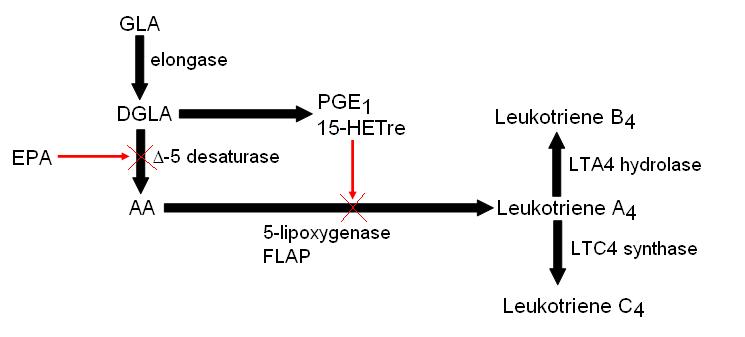Starflower (borage) and evening primrose oils are good sources of the n-6 long chain polyunsaturated fatty acid γ-linolenic acid (GLA, C18:3 (n-6)). In humans GLA is converted to dihomo-γ-linolenic acid (DGLA, C20:3 (n-6)) which is subsequently converted to the anti-inflammatory prostaglandin E1 (PGE1). Because of this, supplementation with GLA can be beneficial to conditions associated with inflammation such as rheumatoid arthritis and skin disorders such as eczema. However, GLA is also metabolised to arachidonic acid (AA, C20:4 (n-6)) which is subsequently converted to the pro-inflammatory series 2 prostaglandins (PGD2, PGE2, PGF2α, PGH2 PGI2, PGJ2) and thromboxanes (TXA2, TXB2) and series 4 leukotrienes (LTA4, LTB4, LTC4, LTD4, LTE4). Dietary strategies to improve inflammatory conditions should therefore aim to optimise conversion of GLA to DGLA and PGE1, but minimise the conversation of GLA to AA and its pro-inflammatory metabolites.
Eicosapentanoic acid (EPA, C20:5 (n-3)) is found in high concentrations in marine oils and is converted in humans to the series 3 prostaglandins and series 5 leukotrienes, that are generally only very mildly pro-inflammatory. Research has shown that when fish oils (containing 3 grams of EPA) is given in combination with starflower oil, the EPA is able to inhibit the conversion of GLA to AA but at the same time allow conversion of GLA to DGLA. Therefore there is a need to maintain the correct ratio of n-6 oils to n-3 oils in order to minimise the formation of pro-inflammatory mediators. EPA is able to inhibit the conversion o GLA to AA because it is an inhibitor of the ∆-5-desaturase enzyme necessary for the conversion. Insulin is able to activate the same enzyme and so controlling the glycaemic response to carbohydrate is also important in maintaining reduced inflammatory conditions.
 Figure 1. Inhibition of inflammation by GLA and EPA. GLA = γ-linolenic acid; EPA = eicosapentanoic acid; DGLA = dihomo-γ-linolenic acid, LT = leukotriene; PG = prostaglandin; HETre = hydroxyeicosatrienoic acid; AA = arachidonic acid
Figure 1. Inhibition of inflammation by GLA and EPA. GLA = γ-linolenic acid; EPA = eicosapentanoic acid; DGLA = dihomo-γ-linolenic acid, LT = leukotriene; PG = prostaglandin; HETre = hydroxyeicosatrienoic acid; AA = arachidonic acid
RdB
